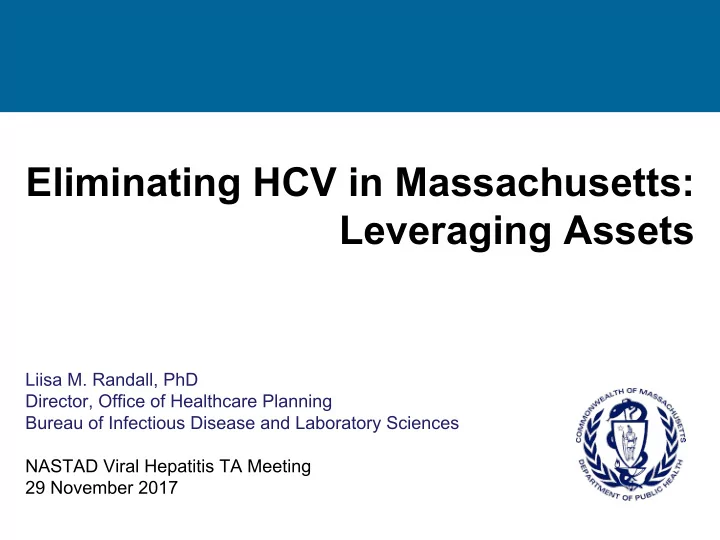

Eliminating HCV in Massachusetts: Leveraging Assets Liisa M. Randall, PhD Director, Office of Healthcare Planning Bureau of Infectious Disease and Laboratory Sciences NASTAD Viral Hepatitis TA Meeting 29 November 2017
Number of Confirmed and Probable HCV Cases Reported in MA by Year, 2007 - 2015 Data source: Massachusetts Department of Public Health, Bureau of Infectious Disease and Laboratory Sciences. Hepatitis C Virus Infection Surveillance Report, 2007 - 2015 . http://www.mass.gov/hepc . Published January 2017. Data as of November 16, 2016 and subject to change.
Confirmed and Probable HCV Cases Reported in MA, 2015 Data source: Massachusetts Department of Public Health, Bureau of Infectious Disease and Laboratory Sciences. Hepatitis C Virus Infection Surveillance Report, 2007 - 2015 . http://www.mass.gov/hepc . Published January 2017. Data as of November 16, 2016 and subject to change.
Number of Reported Confirmed and Probable HCV Cases by Official Massachusetts City/Town*: 2015
Context of HCV in Massachusetts • Enabling policy • Public Health Infrastructure » Clinical capacity for treatment » Deep experience » Universal health care » targeted and integrated services » No treatment restrictions » Novel strategies » SSPs , syringe access » Robust disease surveillance » Birth cohort testing statute » Informatics expertise » State funding » Novel strategy for consuming EHR data » Public health laboratory » Adoption of new/emerging technologies » Commitment to public health intervention
Leveraging Assets: Massachusetts’ Testing/Linkage System • HIV testing and linkage service • SPHL Capacity contracts » Platform allows for co - testing » Conventional testing » 3rd party - billing for testing » Required co - testing HIV & HCV » Retained revenue account » Submission of services data » Required submission to SPHL » Testing/linkage in SSP , OEND , HOC, other venues serving high risk for HCV » Document linkage • Surveillance/Informatics capacity » Linkage verified by surveillance data » Service data augment surveillance
Integrated HIV/HCV/STI Testing Services 2012 – September 2017 • 35 funded agencies • 11 CBOs • 16 CHCs • 7 hospitals • State and local corrections • 120+ sites
Volume HCV Tests/Ab+, 2012 – 2017 40000 6000 HIV/HCV Co - Testing 16% HCV+ 35000 5000 30000 HIV RT Phase - out 4000 25000 20000 3000 Architect 15000 2000 10000 1000 5000 0 0 2012 2013 2014 2015 2016 Jan - Sep 2017 HCV Tests HCV+
Characteristics of HCV+ Jan – Sep 2017 (N=4,360) Other , Undet , MSM , 3% 9% 2% Hetero , 7% Hisp , 21% Black , 10% White , IDU , 66% 81% 31% < 30 yo 20% homeless 34% incarcerated
Leveraging Assets: Success and Opportunities • Program • State Public Health Laboratory • Surveillance
Successes • Program productivity: – 80 % increase in HCV Tests – 90 % increase in HCV Ab + • Identifying infection/linkage: – Statewide 2016: 32% of probable/18% confirmed cases from integrated services system – 36 % of cases identified from integrated services system newly identified – 43% confirmed linked to care
Successes • Public health laboratory capacity – Efficient identification of infection – 3 rd party billing generates revenue to support lab operations • Enhanced surveillance – Enables monitoring of linkage, cure – Timely data for case completion/classification – Facilitates utilization of data for field investigation
Opportunities • New integrated services procurement – Intensified focus on IDU <30 yo – Short - term navigation services • Correctional linkages – Expansion of SSPs
Opportunities: Massachusetts Syringe Services Programs September 2017
Opportunities • Public health laboratory capacity – NAT reflex testing (July 2018) • Strengthening surveillance w/ EMR data – Monitor linkage, retention, cure – Quality improvement
Recommend
More recommend